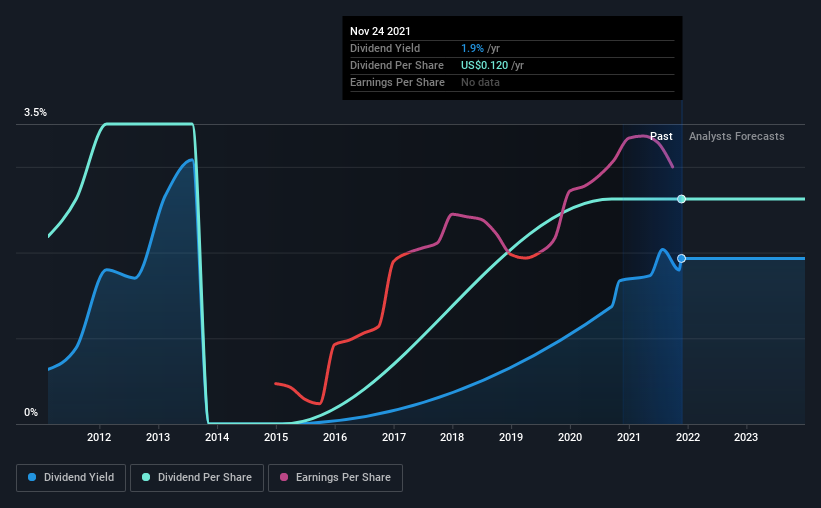Why You Might Be Interested In Kinross Gold Corporation (TSE:K) For Its Upcoming Dividend
Readers hoping to buy Kinross Gold Corporation (TSE:K) for its dividend will need to make their move shortly, as the stock is about to trade ex-dividend. The ex-dividend date is one business day before a company's record date, which is the date on which the company determines which shareholders are entitled to receive a dividend. It is important to be aware of the ex-dividend date because any trade on the stock needs to have been settled on or before the record date. Therefore, if you purchase Kinross Gold's shares on or after the 30th of November, you won't be eligible to receive the dividend, when it is paid on the 15th of December.
The company's next dividend payment will be US$0.03 per share, and in the last 12 months, the company paid a total of US$0.12 per share. Based on the last year's worth of payments, Kinross Gold has a trailing yield of 1.9% on the current stock price of CA$7.87. Dividends are a major contributor to investment returns for long term holders, but only if the dividend continues to be paid. We need to see whether the dividend is covered by earnings and if it's growing.
Check out our latest analysis for Kinross Gold
If a company pays out more in dividends than it earned, then the dividend might become unsustainable - hardly an ideal situation. Kinross Gold paid out just 11% of its profit last year, which we think is conservatively low and leaves plenty of margin for unexpected circumstances. That said, even highly profitable companies sometimes might not generate enough cash to pay the dividend, which is why we should always check if the dividend is covered by cash flow. Thankfully its dividend payments took up just 30% of the free cash flow it generated, which is a comfortable payout ratio.
It's positive to see that Kinross Gold's dividend is covered by both profits and cash flow, since this is generally a sign that the dividend is sustainable, and a lower payout ratio usually suggests a greater margin of safety before the dividend gets cut.
Click here to see the company's payout ratio, plus analyst estimates of its future dividends.
Have Earnings And Dividends Been Growing?
Businesses with strong growth prospects usually make the best dividend payers, because it's easier to grow dividends when earnings per share are improving. If earnings fall far enough, the company could be forced to cut its dividend. It's encouraging to see Kinross Gold has grown its earnings rapidly, up 59% a year for the past five years. Earnings per share have been growing very quickly, and the company is paying out a relatively low percentage of its profit and cash flow. Companies with growing earnings and low payout ratios are often the best long-term dividend stocks, as the company can both grow its earnings and increase the percentage of earnings that it pays out, essentially multiplying the dividend.
Another key way to measure a company's dividend prospects is by measuring its historical rate of dividend growth. Since the start of our data, 10 years ago, Kinross Gold has lifted its dividend by approximately 1.8% a year on average. Earnings per share have been growing much quicker than dividends, potentially because Kinross Gold is keeping back more of its profits to grow the business.
Final Takeaway
From a dividend perspective, should investors buy or avoid Kinross Gold? It's great that Kinross Gold is growing earnings per share while simultaneously paying out a low percentage of both its earnings and cash flow. It's disappointing to see the dividend has been cut at least once in the past, but as things stand now, the low payout ratio suggests a conservative approach to dividends, which we like. There's a lot to like about Kinross Gold, and we would prioritise taking a closer look at it.
In light of that, while Kinross Gold has an appealing dividend, it's worth knowing the risks involved with this stock. Case in point: We've spotted 2 warning signs for Kinross Gold you should be aware of.
A common investment mistake is buying the first interesting stock you see. Here you can find a list of promising dividend stocks with a greater than 2% yield and an upcoming dividend.
This article by Simply Wall St is general in nature. We provide commentary based on historical data and analyst forecasts only using an unbiased methodology and our articles are not intended to be financial advice. It does not constitute a recommendation to buy or sell any stock, and does not take account of your objectives, or your financial situation. We aim to bring you long-term focused analysis driven by fundamental data. Note that our analysis may not factor in the latest price-sensitive company announcements or qualitative material. Simply Wall St has no position in any stocks mentioned.
Have feedback on this article? Concerned about the content? Get in touch with us directly. Alternatively, email editorial-team (at) simplywallst.com.

 Yahoo Finance
Yahoo Finance 
